Contrary to popular belief, terrariums don’t require complex methods or materials to create captivating results.
With the right DIY approach – and some reliable plant choices – creating beautiful living art has never been so easy. Even the simplest of terrariums can look professional if they follow these horticultural principles.
That’s why, in this article, we’re going back to basics.
I’ll show you how to make a terrarium in the most straightforward process. Taking you through every step from the ground up and telling you everything you need (and don’t need) along the way.
So, let’s dig in!

Terrarium Tribe is reader-supported. When you purchase through links on our site, we may earn an affiliate commission (at no further cost to you). 💜
DIY Terrarium Guide: Getting Started
Closed Terrarium 101
First things first, let’s make sure we’re talking about the same type of terrarium here.
After all, modern terrariums come in many forms nowadays. However, they’re broadly divided into two categories: open terrariums and closed terrariums.
This distinction is crucial as it will drive both the process and terrarium supplies you’ll be needing.
All those colorful dish gardens and Pinterest-perfect succulent terrariums? Yeah, we’re not tackling those today… Open terrariums have their place, but we’re building a functional plant terrarium here, so we’re talking exclusively about closed terrariums.
The kind that can trap humidity and generate a lovely tropical environment for our plants.
After all, the original terrarium (the Wardian Case) was designed to transport tropical plants around the world. Now we’re going to pay homage to that history by creating a stunning slice of nature for our home.
So, let’s get to making one!
Glass Terrarium Containers
Almost any glass container can become a beautiful terrarium.
That said, the shape and size definitely have an effect on how easy they are to plant up.
Basically, the wider the opening, the easier it is to work with. So, I wouldn’t recommend starting with a bottle terrarium. They really are as tricky as they look!
Instead, I’d look for the likes of goldfish bowls, vases, aquariums, and larger mason jars… you get the idea. It needn’t be fancy; you can get some great glassware from thrift stores, online marketplaces, and TK Maxx (TJ Maxx in the States).
If you can get your hand inside it, you’re on to a winner.
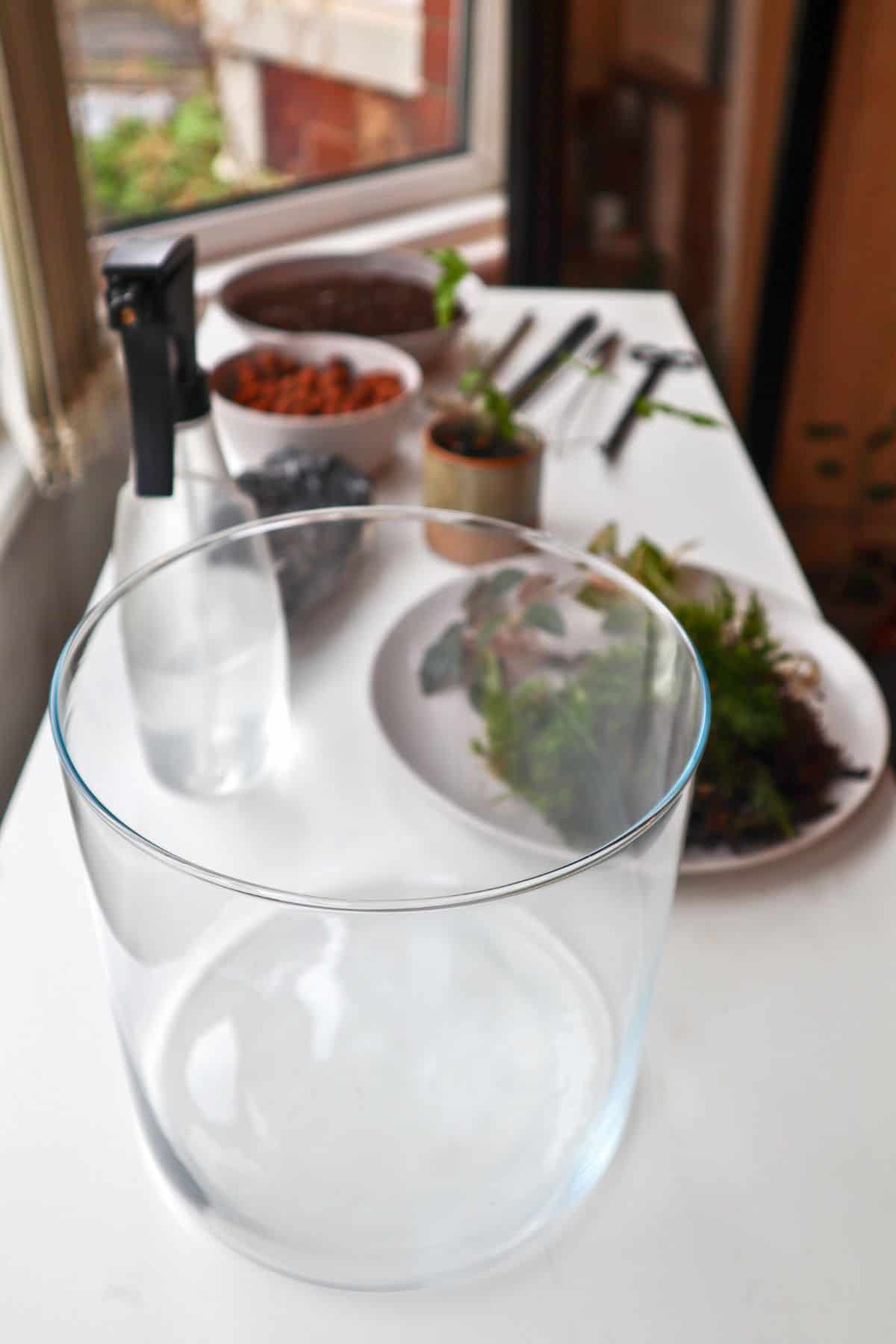
For practical sourcing advice, check out my guide to picking suitable containers for terrariums.
Ideally, they’ll be closed containers with existing lids, but don’t worry if your chosen container is lidless (they so often are, and the one we’re using is).
We have several terrarium lid solutions at our disposal, and Cling film (saran wrap) works just fine as a quick fix too.
Choosing Terrarium Plants
Choosing your plants is naturally the most exciting (and possibly the most crucial) part of the project.
To match the high humidity and temperature found in a closed terrarium environment, you’ll need to use exclusively tropical plants.
That’s right, cowboy, put the succulents and cacti down!
You’ll also want to consider the size and growth of your potential plants. Working with such limited space, if you want a terrarium project that’s as easy to maintain as it is to build, then stick to miniature varieties and slower growers.
That said, if you don’t mind regular trimming, then the plant world is your oyster.
To help you make your decision, you can peruse our guides to closed terrarium plants and the best terrarium plants for beginners. Both have an abundance of plant inspiration and terrarium-friendly options.
Okay, so where do we start in picking our terrarium plants?
To keep things simple, I’d look to choose from a few categories for a vibrant, natural-looking scene.
- Foliage – You’ll need a show-stopping feature plant (or two) in the foreground to create a point of focus and a splash of color.
Top Picks: Polka Dot Plants and Nerve Plants are both classic beginner terrarium plants. The Pilea genus also has some gorgeous options in the Aluminum Plant and the Moon Valley Pilea.
- Ferns – Ferns almost universally make fantastic terrarium plants. They are the kings and queens of texture, and they adore high humidity and warmth. Not to mention, there are so many terrarium fern varieties to choose from.
Top Picks: I’m partial to a miniature Sword Fern (the Lemon Button Fern makes an appearance in almost all of my terrariums), but today I’m using a Pteris Fern.
- Vines – Most of us won’t have the terrarium space to grow a bulletproof Pothos plant, but thankfully there are some equally reliable miniature terrarium vines that fit the bill.
Top Picks: For smaller builds, both Ficus pumila and Pilea glauca spring to mind, as does the entire Selaginella (Clubmoss) genus. I’m also a fan of Syngonium (particularly the Pixie variety!).
- Moss – Moss is the cherry on top of the terrarium cake and really brings the whole woodland/tropical look together spectacularly. Check out our picks for the best moss for terrariums for the full breakdown.
Top Picks: The two standout “clumpy” mosses for terrariums are Cushion Moss (Bun Moss) and Mood Moss, and our favorite sheet moss to work with is Hypnum Moss.
How to Make Terrarium Layers (Step-by-Step)
1. Drainage
A drainage layer (commonly known as a terrarium false bottom) is there to make your life easier.
Essentially, they provide a space for excess water to drain, and they act as a failsafe to protect your plants from root rot if you accidentally add too much water to the system. Which is all too easily done…
To get started, we simply need to add a layer of suitable drainage material at the bottom of the container.
Gravel is a common and inexpensive option, but I like to use porous materials where possible (e.g., lava rock or leca) as they’re lighter and bring some additional benefits for your plant roots.
👉 You can shop leca in terrarium-ready sizes on our store.
An inch is enough for most projects.
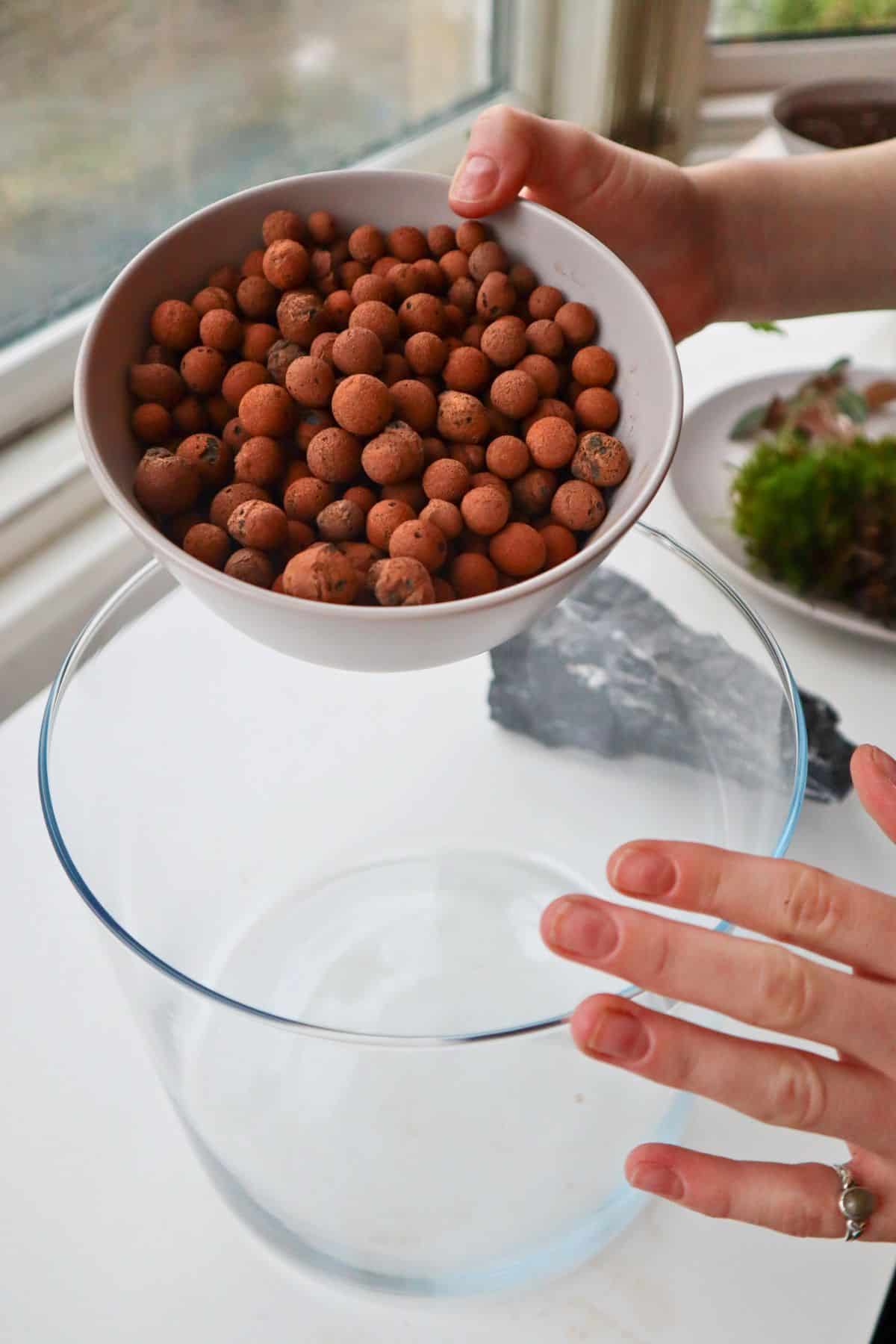
As part of the drainage layer(s), this is where you can opt to add a mesh screen and/or an activated charcoal layer too.
Both provide benefits – the former to keep substrate out of the drainage layer and the latter for filtration.

If you want to keep things streamlined, you can skip them (neither is strictly necessary), but both are recommended for terrarium longevity.
👉 Check out mesh and activated charcoal on our shop.
2. Soil / Substrate
Next, the all-important soil layer – getting a good quality substrate is imperative.
We need something that will drain well, retain moisture, and provide nutrients.
To keep things straightforward, I recommend choosing a purpose-made mix (why make life difficult?).
If you have any to hand, the classic ABG mix is always a solid choice, but any high-quality tropical, fern, or terrarium mix should work just fine.
Naturally, I’m going to recommend our premium terrarium substrate mix here. Our mix is made of coco coir, horticultural charcoal, worm castings, and orchid bark – it’s perfect for the job! 👇

(If all you have is potting soil, it can work, but it’s far from ideal in terms of terrarium longevity).
As far as depth goes here, you’ll need to add enough to comfortably house your plants’ roots. For reference, mine ended up around three inches deep where I put my plants, but naturally, this depends on which plants you have.
See our guide to creating the best terrarium substrate for help in customizing a mix for your project.
3. Hardscape
Okay, so hardscape isn’t an essential part of a terrarium.
But it’s such an easy way to elevate the whole thing, I really do recommend it.
Seriously, a single hardscape element can quickly take your terrarium from zero to hero. Providing much-needed texture and structure to your build, it’ll draw the eye up, contrast your plants, and bring together a natural look.
All of this by just adding a rock or branch to a terrarium? Worth it!
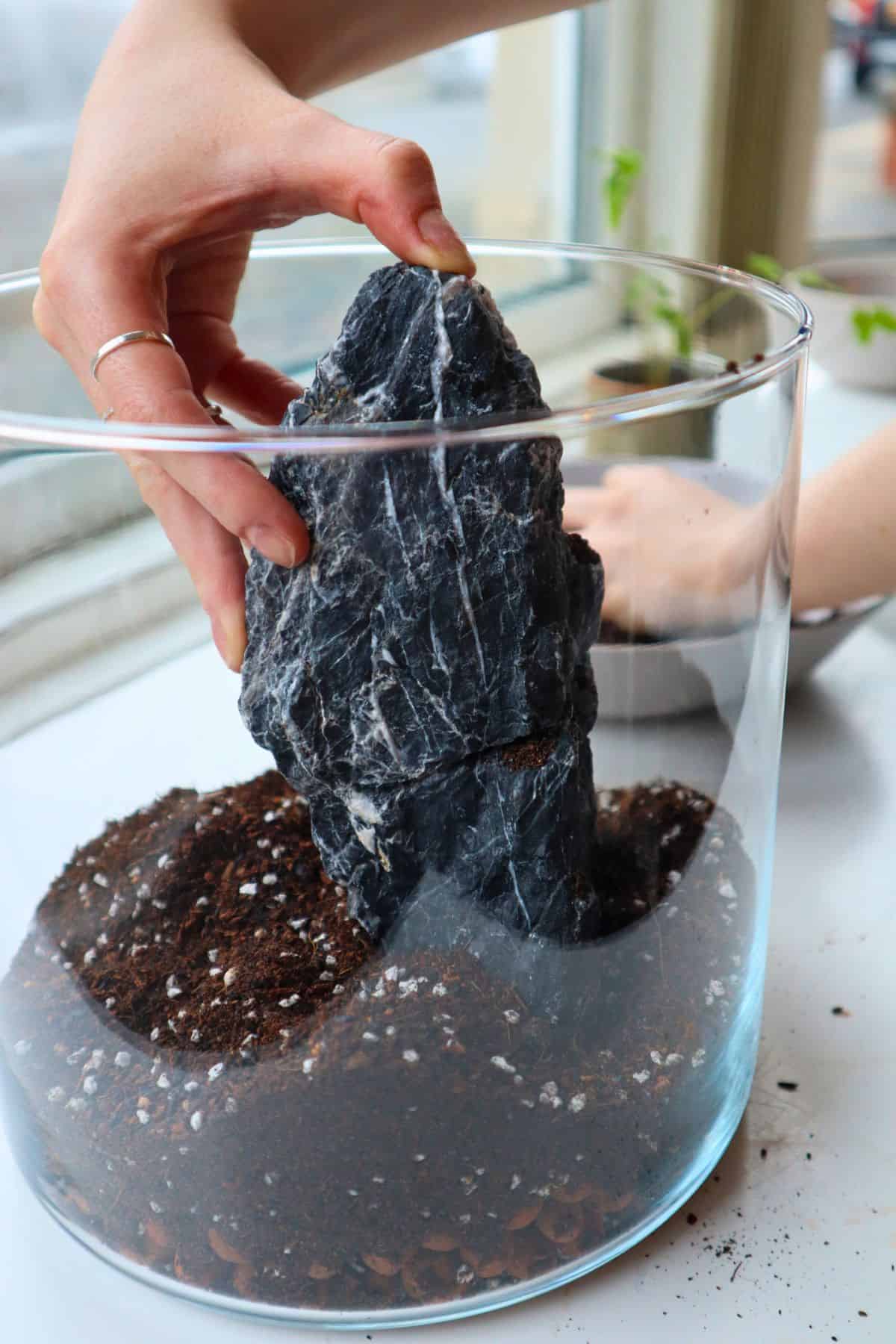
In my experience, rocks can be a little easier to maneuver and anchor in the substrate, but you can choose any terrarium rock or driftwood that takes your fancy.
Partially burying your hardscape can be a good way to add some stability, packing in the substrate around the base. You don’t want anything falling over and cracking the glass…
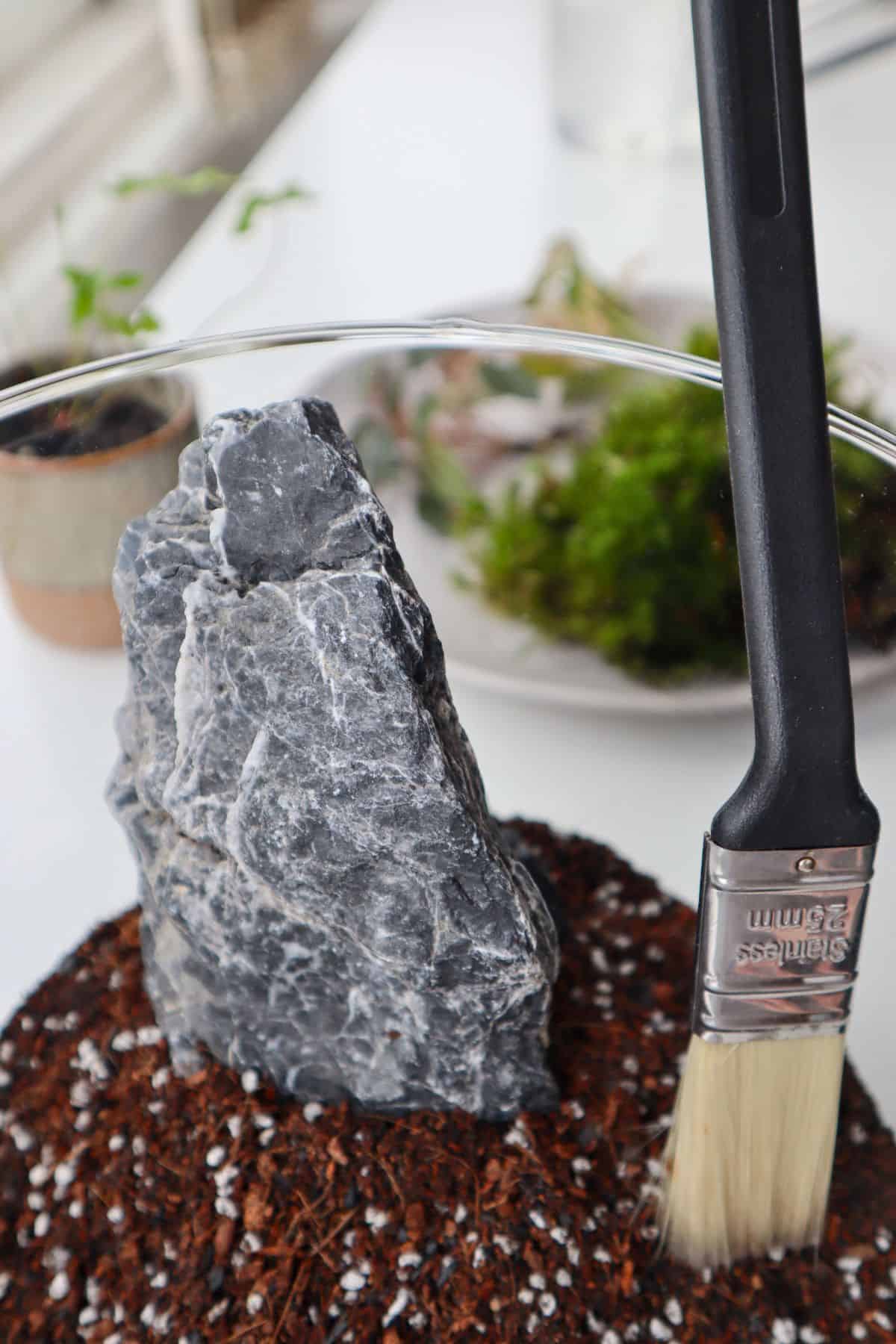
4. Plants
At long last, it’s time to plant up!
I recommend starting with your tallest/largest plant and working your way to the smallest. This helps you keep a sense of the scale and create visually stunning levels.
Create a hole in the substrate (the end of your brush will do the job nicely) and pop your plant’s roots in, smoothing the substrate around it to keep it in place.
Pro Tip: If you find this tricky, you can give the substrate a light watering with a spray bottle. A damp substrate can be easier to work with, but don’t soak it.
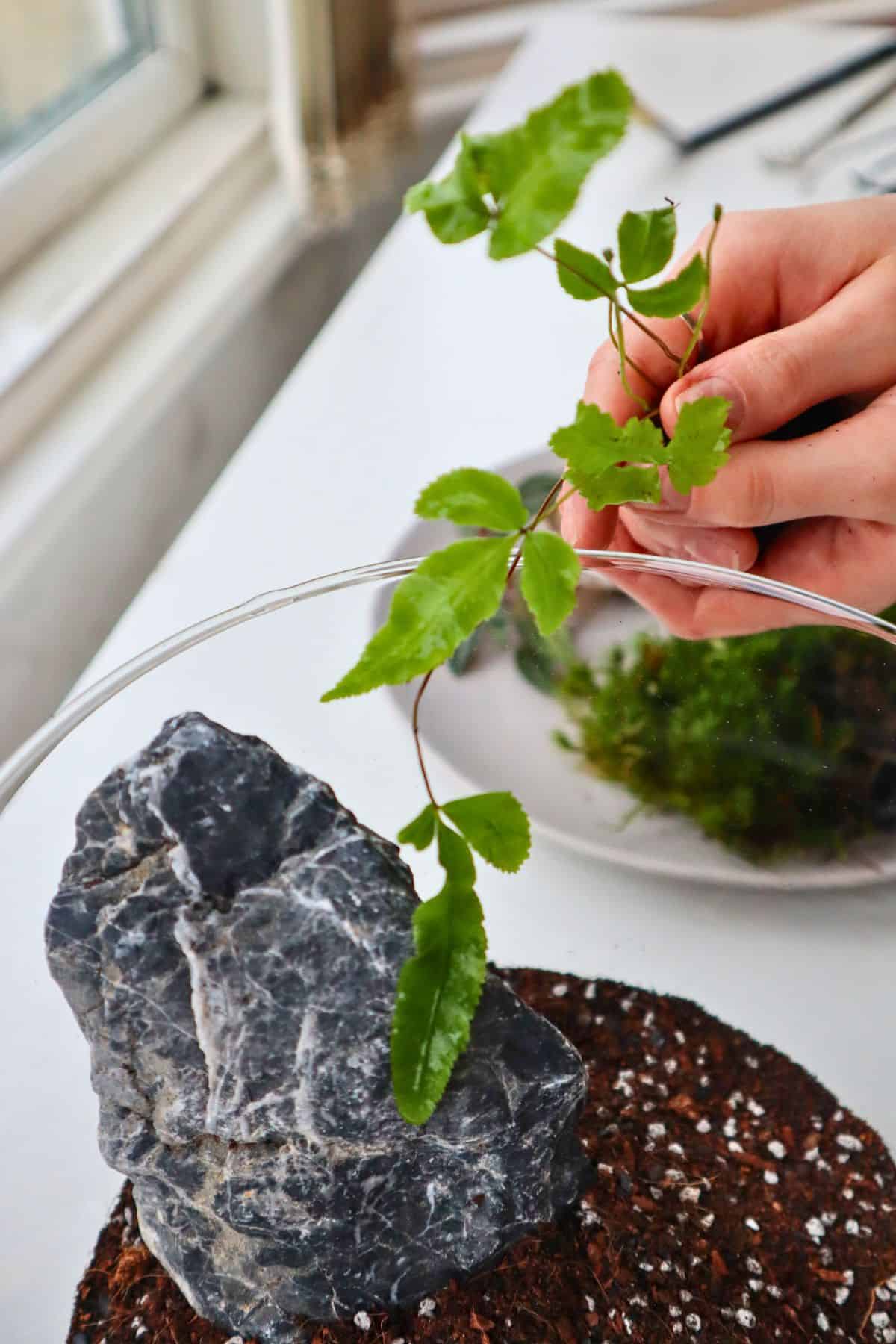
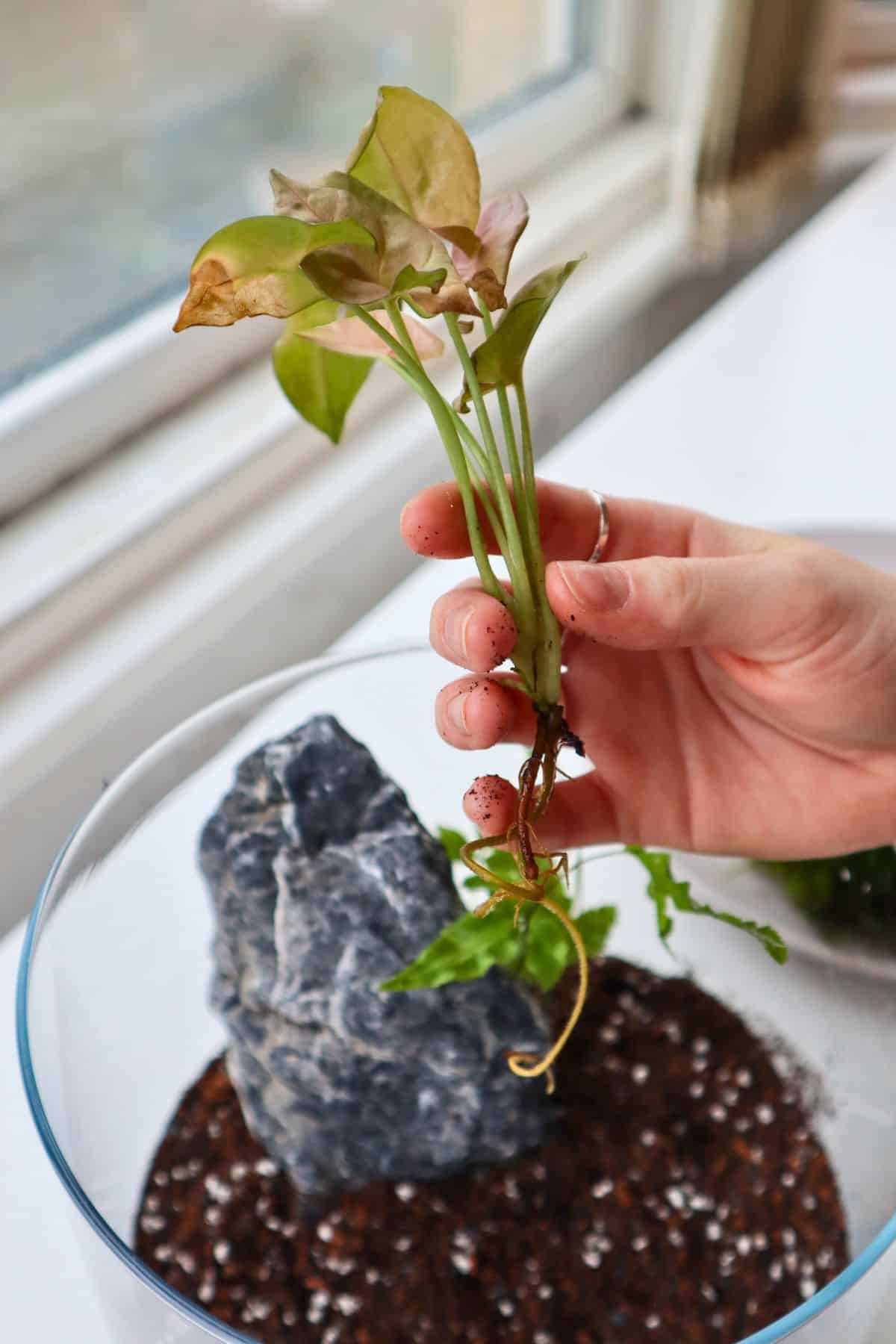
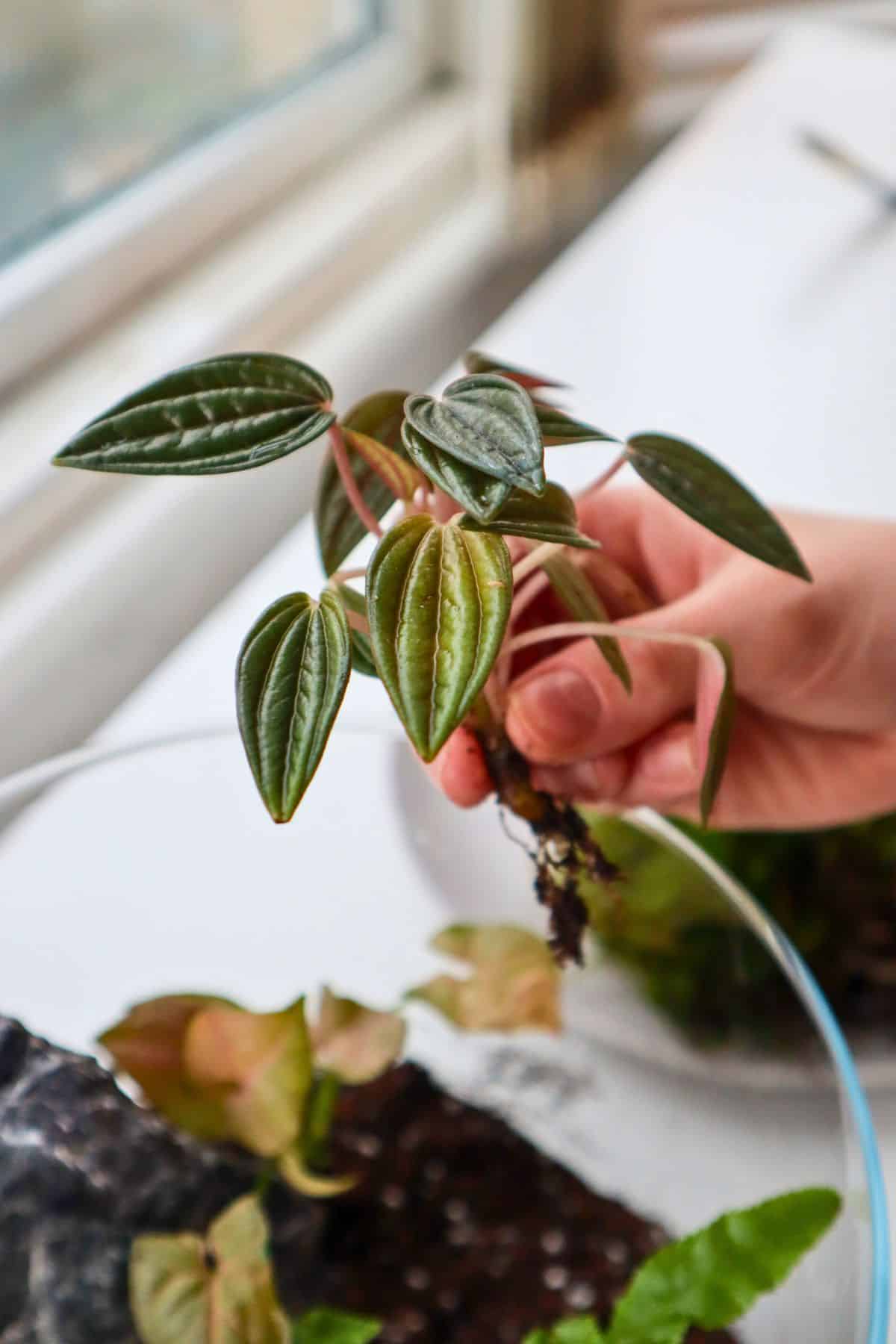
Now that the main plants are in place, it’s time to pull it all together with moss. That’s what completes the “natural look” of our miniature forest garden. It’s also my favorite part!
Start by grabbing your clumpy moss of choice and tease apart a tuft the size you’d like (you may need to trim off the fibrous excess underneath it).
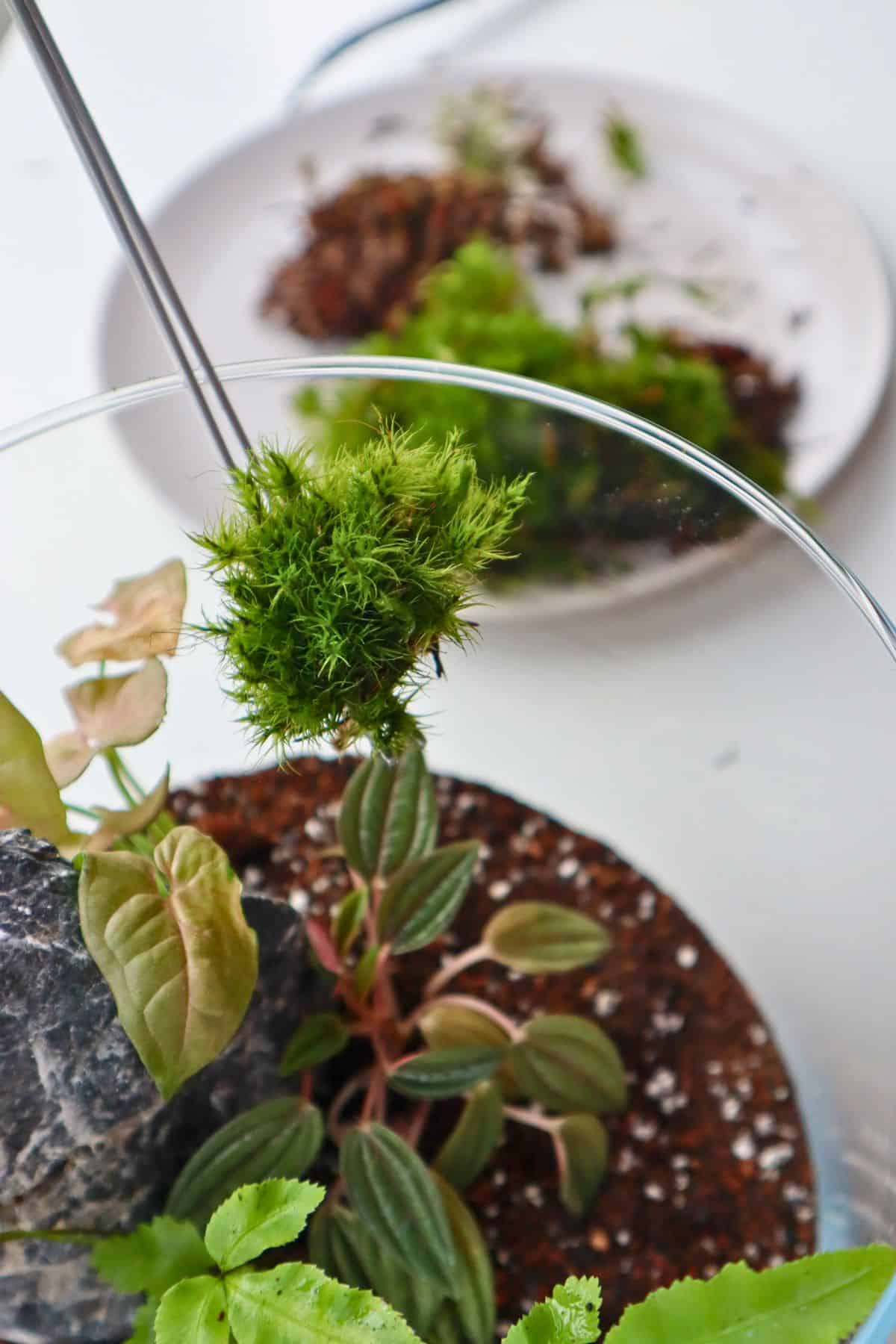
Simply place it where you’d like it in your terrarium, with the green bit facing outwards towards the viewer. Then continue till satisfied.
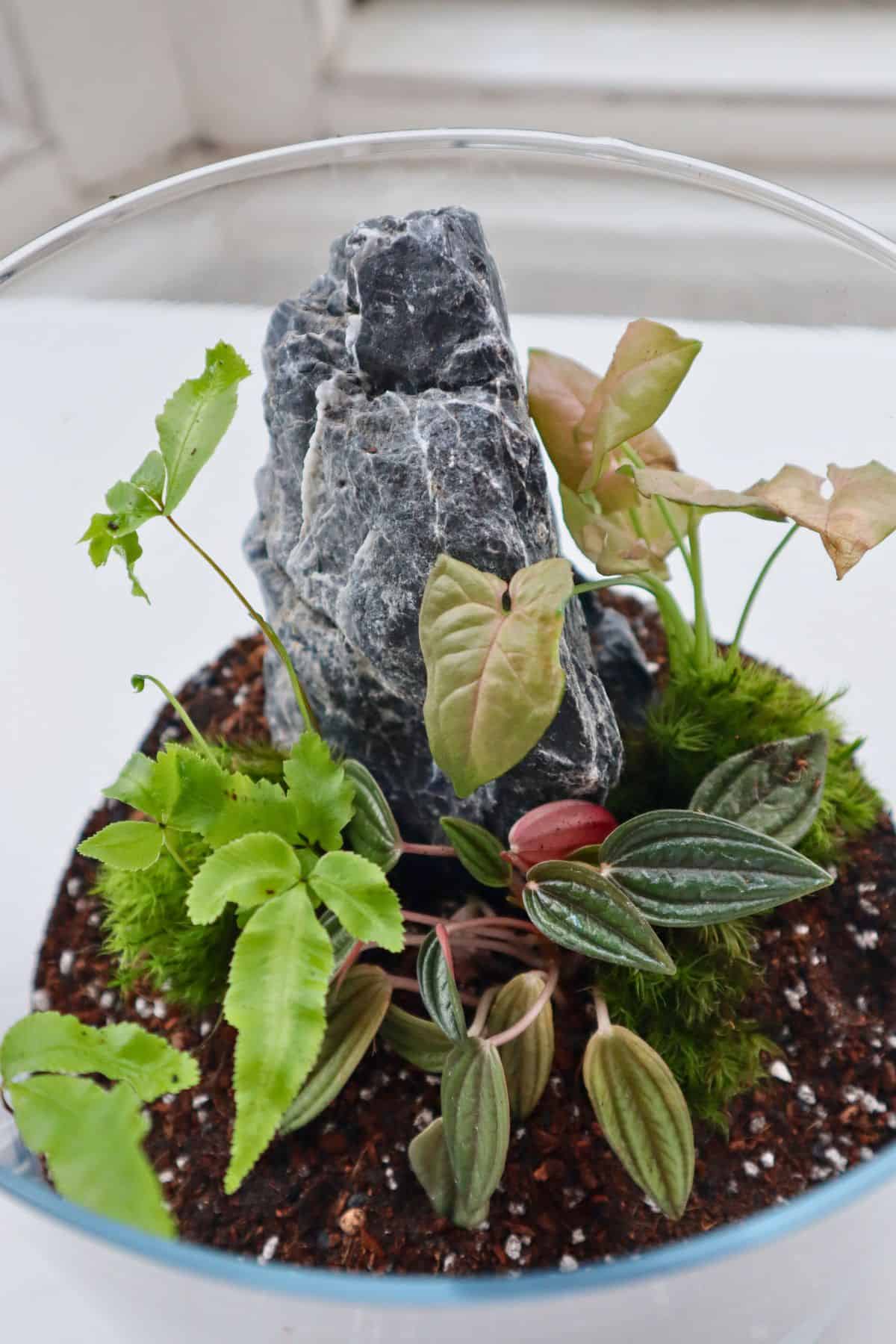
These kinds of mosses won’t grow outwards a whole lot, so if you want full moss coverage, then keep adding until all of the substrate is covered.
5. Finishing Touches
Voila, the terrarium is done!
All that’s left is to do is give it a light watering with a spray bottle and seal it up.
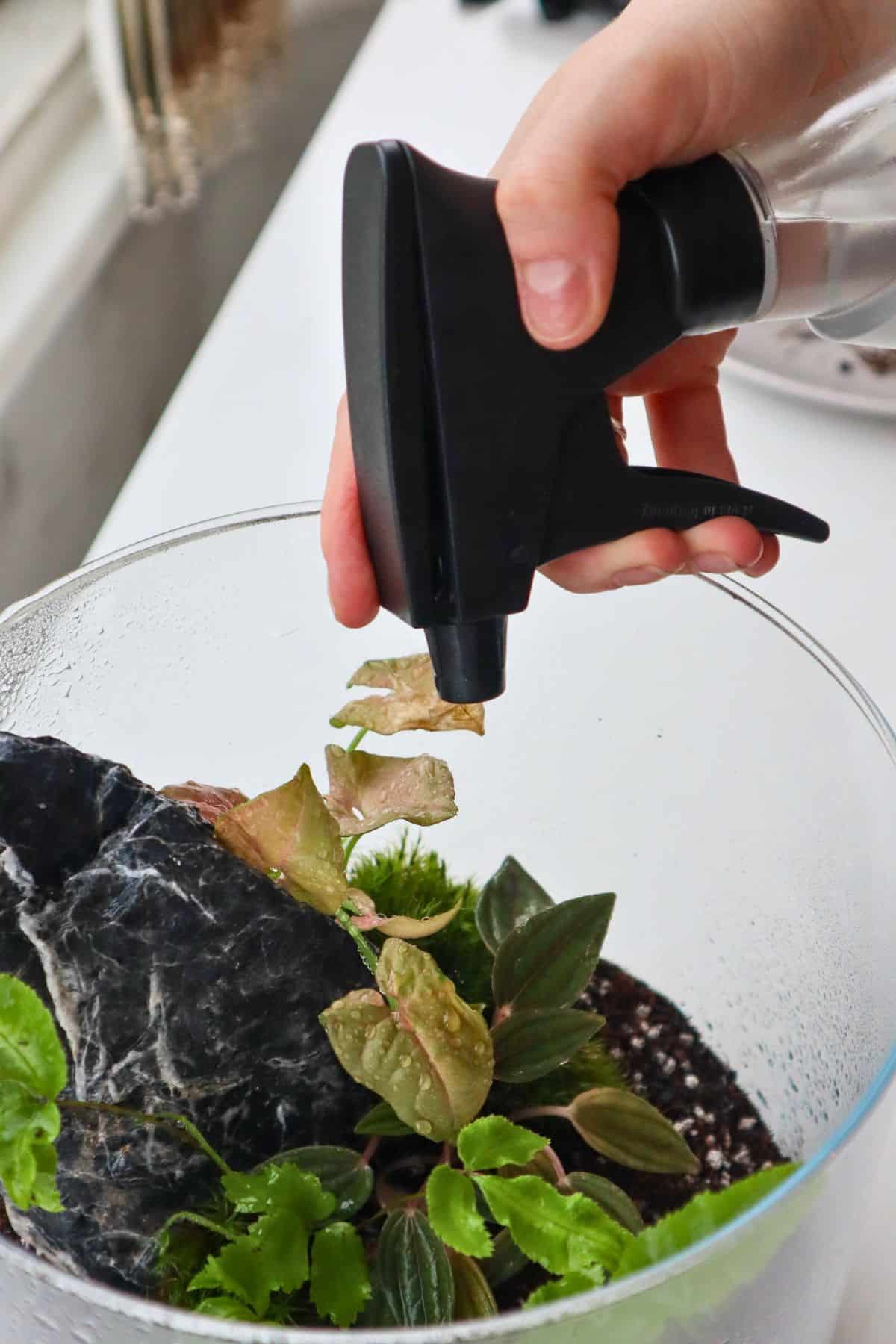
If you have a lid, then feel free to pop it on and marvel at your new creation. If not, here’s an easy solution using some Saran Wrap.
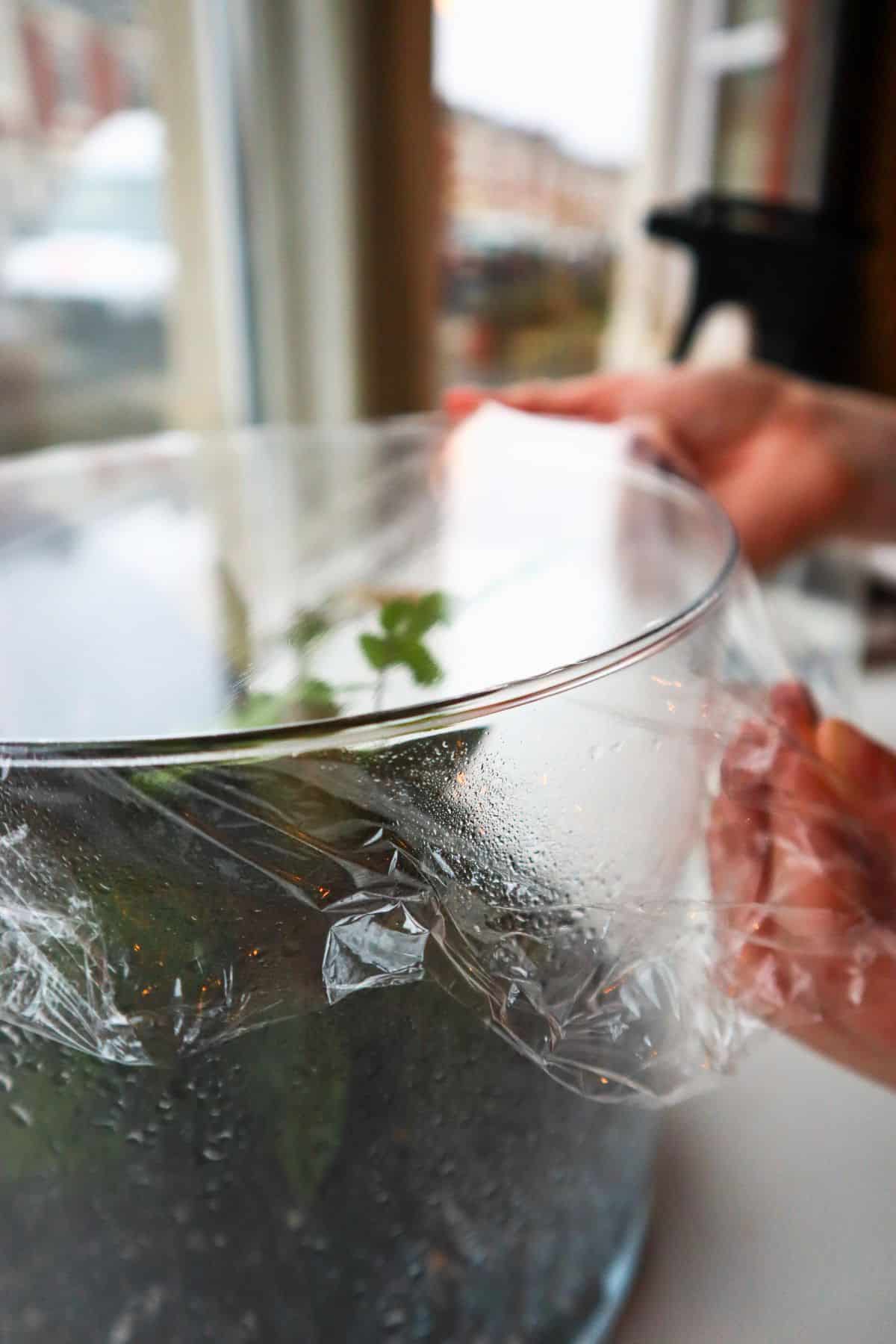
Basic Terrarium Care and Maintainance
A well-built terrarium ecosystem mostly looks after itself (and following this guide should get you there).
That said, they’re rarely a completely hands-off care experience. Even once you’ve got the basics down, they still need a little attention/maintenance every so often.
Here are the main points to look out for.
- Light – Keep your terrarium in a spot where it receives plenty of bright indirect sunlight. An hour of direct sunlight here and there is generally fine, but too much will scorch your plants.
- Water – Knowing how to water a terrarium properly is half the battle. If the substrate looks bone dry and/or your plants are wilting, add a couple of extra sprays where needed. You want the substrate to be evenly moist but never sodden.
- Mold – One (super common) problem with new terrariums is a mold outbreak. The heat and humidity make terrariums an ideal environment for mold. Don’t panic if this happens! It’s totally normal, and there are a variety of ways to deal with mold in terrariums.
A great way to avoid mold issues from day one is to add a colony of springtails and make a bioactive terrarium. These tiny detritivorous insects that feed off mold – handy, right?

That’s a Wrap on How to Make a Terrarium
Phew, you made it.
I hope you’ve fallen head over heels in love with your new terrarium.
If you want to show it off, make sure you post it on Instagram and tag us (@terrariumtribe). We’d love to see it, and we’re always happy to share it with our ever-growing terrarium community!
Alternatively, if you want an even easier start to your project, you could check out our favorite terrarium kits.

This is very helpful, I recently started building terrariums as a hobby and I love it. I have one terrarium with a heart fern that had a couple of moldy leaves that I trimmed back. It’s a small terrarium, so I’m not sure springtails are the best option. Can you offer any suggestions? How does one control the springtail population? Thanks!
Hi Sarah, even small terrariums are suitable for Springtails (and the population will generally take care of itself). They’re definitely the best way of managing mold – but there are other things that can help too.
What kind of terrarium would you recommend for someone that travels a lot? Basically I want to be off for a month (without having to ask a friend to come and look after my terrarium), come back, and still have the plants alive 😅
A closed terrarium that’s already been established for a few months is your best bet – we’ve had terrariums we can leave much longer than a month, but in the beginning they usually need a bit of tweaking to get the cycle balanced. That said, when we were going away for a few months we gave ours to our family to care for, they didn’t listen to instructions, and the terrariums are no more 😂
I thank you for this information because I love fairy gardens. So I’m going to make my first terrarium and incorporate a fairy garden scene with it.
How much does a terrarium like this cost. i already have the container and drainage material (gravel). i am planning on doing a tropical sealed terrarium.
Hi Conrad – check out our “how much does a terrarium cost” post 🙂
I recently went to a place where I built my own terrarium using plants the place gave me. Some had roots and others did not. Which types of plants need roots and which can be planted just by the stem?
Hi Nancy – it completely depends on the plant, but many tropical plant cuttings will root up readily in a container. Check out Pilea glauca, Calissia repens and Ficus pumila.
Hello. What would you recommend as the key tools to get when starting out making closed terrariums?
Hey – check out our terrarium tools article for that info :).
Hi Dan!
Thank you for your advice on terrariums! I love them and eventually want to create bigger ones. Right now though, I’ve got a tiny apothecary jar terrariums. It wasn’t doing too well so I moved it to a new location and it is really thriving there. This is great, but the plants have been growing out of control – so much so they have started to lift the top of the jar and I cannot see the other plants (mosses). I’m not sure what to do about that. Is it safe to prune?
Thanks!
Brooke
No worries Brooke, sounds like you’re doing something right! Absolutely, it’s safe (and recommended to prune) where necessary, otherwise some plants might end up hogging all the light and resources.
Thanks so much for this. My son gave me a Bioactive one for Christmas and he’s so proud of his efforts. It is lovely but I know nothing about them! A Google search left me feeling completely overwhelmed and expecting a slow decline for his pressie. But this definitely gives me hope. And a new found interest 😁
Great
I’m just getting started and bought all the supplies from your shop, including a batch of springtails. My question: is there anything wrong with eventually adding some pillbugs from my own yard, fancy though they be not?
We don’t typically recommend it simply because it’s hard to know what you’re getting. They may be a species that’s unsuitable for terrarium life, loves to eat plants, or carries infections. That’s why we recommend and sell captive-bred, tried and tested cleanup crew species (and thanks so much for getting your supplies from us!).
Amazing articles, Dan and Rea!
I built my own Terrarium and it looks gorgeous. I used the tips on your website and the outcome is better than what I imagined. Thank you so much!